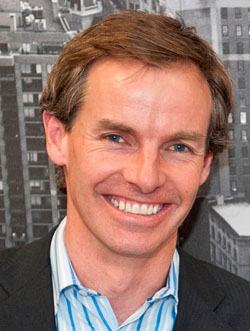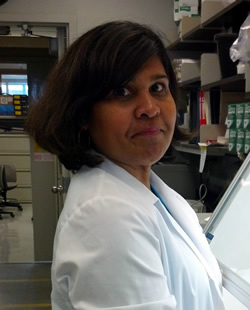A recurring
theme in HIV cure research is the barrier presented by latent HIV infection.
Current antiretroviral therapy (ART) can reduce active virus growth to
undetectable levels. But there remains an extremely stable reservoir of virus invulnerable
to attack by these drugs.
 Dr. Julian ElliottOne strategy
to overcome this latent reservoir is to activate the latent cells, making the virus
susceptible to ART. During the course of a prior ARCHE (amfAR Research
Consortium on HIV Eradication) study, it was discovered that disulfiram, a drug
that is approved by the FDA for the treatment of alcoholism, could activate latent
HIV in the test tube. Dr. Julian Elliott of Monash University in Melbourne,
Australia, along with Dr. Steven Deeks of the University of California, San
Francisco, now plan to determine whether this concept could be effective in
patients.
Dr. Julian ElliottOne strategy
to overcome this latent reservoir is to activate the latent cells, making the virus
susceptible to ART. During the course of a prior ARCHE (amfAR Research
Consortium on HIV Eradication) study, it was discovered that disulfiram, a drug
that is approved by the FDA for the treatment of alcoholism, could activate latent
HIV in the test tube. Dr. Julian Elliott of Monash University in Melbourne,
Australia, along with Dr. Steven Deeks of the University of California, San
Francisco, now plan to determine whether this concept could be effective in
patients.
Drs. Elliot
and Deeks will give different doses of disulfiram to four groups of 10 adult
volunteers with stable HIV infection on ART, daily for three days. This is
known as a dose escalation study. Apart from safety monitoring, they will
evaluate the effect of this drug on the growth of HIV in T cells and plasma.
They will also see if the size of a patient’s latent HIV reservoir is altered
by treatment.
A second
ARCHE grant was awarded to Dr. Timothy Henrich of Harvard Medical School and
Brigham and Women’s Hospital. He will study two HIV-positive individuals who
had been on long-term ART when they developed lymphomas. To treat their cancer,
both underwent typical stem-cell transplants from donors who had been selected
only for tissue-type match. But Dr. Henrich found something extraordinary. Not
only were these individuals cured of their cancer, but he could find no
evidence of HIV infection. While the “Berlin patient” was cured of HIV
following transplant with cells from a donor selected for the CCR5 delta32 mutation,
and thus resistant to  Dr. Deborah PersaudHIV infection, in a procedure involving highly toxic
total body radiation and anti-T cell antibodies, no extraordinary measures were
used here. For the moment, these two individuals remain on ART. But with amfAR
funding, Dr. Henrich will interrupt their ART and search for HIV in their blood
and other tissues. He will also assess the size of their HIV reservoir if any
latent virus is uncovered.
Dr. Deborah PersaudHIV infection, in a procedure involving highly toxic
total body radiation and anti-T cell antibodies, no extraordinary measures were
used here. For the moment, these two individuals remain on ART. But with amfAR
funding, Dr. Henrich will interrupt their ART and search for HIV in their blood
and other tissues. He will also assess the size of their HIV reservoir if any
latent virus is uncovered.
A third grant
was awarded to Dr. Deborah Persaud of Johns Hopkins and Dr. Katherine Luzuriaga
of the University of Massachusetts. They will determine if it is possible to
cure an HIV infection with ART alone in children in whom ART had been started
soon after birth and continued for an average of 15 years. Drs. Persaud and
Luzuriaga have a group of five such children with no detectable HIV, who remain
HIV antibody negative. The researchers will use highly sophisticated tests to
search for active and latent virus.
We are very
excited about the prospects of these three new studies to advance our goal of
finding a practical cure for HIV/AIDS.
To view the press release click here.
Dr. Laurence is amfAR’s senior
scientific consultant.